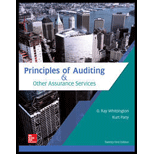
Principles Of Auditing & Other Assurance Services
21st Edition
ISBN: 9781259916984
Author: WHITTINGTON, Ray, Pany, Kurt
Publisher: Mcgraw-hill Education,
expand_more
expand_more
format_list_bulleted
Textbook Question
Chapter 7, Problem 32QRA
During your first audit of a medium-size manufacturing company, the owner, John Bell, explains that in order to establish clear-cut lines of responsibility for various aspects of the business, he has made one employee responsible for the purchasing, receiving, and storing of merchandise. A second employee has full responsibility for maintenance of
Expert Solution & Answer
Want to see the full answer?
Check out a sample textbook solution
Students have asked these similar questions
hello teacher please solve questions
hi expert please help me
need help this answer
Chapter 7 Solutions
Principles Of Auditing & Other Assurance Services
Ch. 7 - Prob. 1RQCh. 7 - Prob. 2RQCh. 7 - Prob. 3RQCh. 7 - Prob. 4RQCh. 7 - Prob. 5RQCh. 7 - Prob. 6RQCh. 7 - Prob. 7RQCh. 7 - Identify the four types of control activities and...Ch. 7 - One basic concept of internal control is that no...Ch. 7 - Prob. 10RQ
Ch. 7 - Prob. 11RQCh. 7 - Prob. 12RQCh. 7 - Prob. 13RQCh. 7 - Prob. 14RQCh. 7 - Prob. 15RQCh. 7 - Prob. 16RQCh. 7 - Prob. 17RQCh. 7 - Prob. 18RQCh. 7 - Prob. 19RQCh. 7 - Prob. 20RQCh. 7 - Prob. 21RQCh. 7 - Prob. 22RQCh. 7 - Prob. 23RQCh. 7 - Management is responsible for designing and...Ch. 7 - Prob. 25QRACh. 7 - Prob. 26QRACh. 7 - Prob. 27QRACh. 7 - Prob. 28QRACh. 7 - Prob. 29QRACh. 7 - Prob. 30QRACh. 7 - Prob. 31QRACh. 7 - During your first audit of a medium-size...Ch. 7 - Prob. 33QRACh. 7 - Prob. 34QRACh. 7 - Which of the following would be least likely to be...Ch. 7 - Prob. 35BOQCh. 7 - Prob. 35COQCh. 7 - Prob. 35DOQCh. 7 - Prob. 35EOQCh. 7 - Prob. 35FOQCh. 7 - Prob. 35GOQCh. 7 - Prob. 35HOQCh. 7 - Which of the following is not an advantage of...Ch. 7 - Prob. 35JOQCh. 7 - Prob. 35KOQCh. 7 - Prob. 35LOQCh. 7 - Prob. 36OQCh. 7 - Listed below are controls that have been developed...Ch. 7 - Prob. 38OQCh. 7 - For each term in the first column, find the...Ch. 7 - Prob. 40AOQCh. 7 - Prob. 40BOQCh. 7 - Prob. 40COQCh. 7 - Prob. 40DOQCh. 7 - Prob. 40EOQCh. 7 - Prob. 41PCh. 7 - Prob. 42PCh. 7 - Prob. 43PCh. 7 - Prob. 44PCh. 7 - Prob. 45ITC
Knowledge Booster
Learn more about
Need a deep-dive on the concept behind this application? Look no further. Learn more about this topic, accounting and related others by exploring similar questions and additional content below.Similar questions
- For each of the transactions above, indicate the amount of the adjusting entry on the elements of the balance sheet and income statement.Note: Enter negative amounts with a minus sign.arrow_forwardNeed help with this question solution general accountingarrow_forwardDon't use ai given answer accounting questionsarrow_forward
- I want to correct answer general accounting questionarrow_forwardKindly help me with accounting questionsarrow_forwardDuo Corporation is evaluating a project with the following cash flows: Year 0 1 2 3 Cash Flow -$ 30,000 12,200 14,900 16,800 4 5 13,900 -10,400 The company uses an interest rate of 8 percent on all of its projects. a. Calculate the MIRR of the project using the discounting approach. Note: Do not round intermediate calculations and enter your answer as a percent rounded to 2 decimal places, e.g., 32.16. b. Calculate the MIRR of the project using the reinvestment approach. Note: Do not round intermediate calculations and enter your answer as a percent rounded to 2 decimal places, e.g., 32.16. c. Calculate the MIRR of the project using the combination approach. Note: Do not round intermediate calculations and enter your answer as a percent rounded to 2 decimal places, e.g., 32.16. a. Discounting approach MIRR b. Reinvestment approach MIRR c. Combination approach MIRR % % %arrow_forward
- Provide correct answer general accounting questionarrow_forwardNeed help with this question solution general accountingarrow_forwardConsider a four-year project with the following information: Initial fixed asset investment = $555,000; straight-line depreciation to zero over the four-year life; zero salvage value; price = $37; variable costs = $25; fixed costs = $230,000; quantity sold = 79,000 units; tax rate = 24 percent. How sensitive is OCF to changes in quantity sold?arrow_forward
arrow_back_ios
SEE MORE QUESTIONS
arrow_forward_ios
Recommended textbooks for you
 Auditing: A Risk Based-Approach (MindTap Course L...AccountingISBN:9781337619455Author:Karla M Johnstone, Audrey A. Gramling, Larry E. RittenbergPublisher:Cengage Learning
Auditing: A Risk Based-Approach (MindTap Course L...AccountingISBN:9781337619455Author:Karla M Johnstone, Audrey A. Gramling, Larry E. RittenbergPublisher:Cengage Learning

Auditing: A Risk Based-Approach (MindTap Course L...
Accounting
ISBN:9781337619455
Author:Karla M Johnstone, Audrey A. Gramling, Larry E. Rittenberg
Publisher:Cengage Learning
Ethical Decision Making in Management; Author: GreggU;https://www.youtube.com/watch?v=6UrBO-cL27Q;License: Standard Youtube License